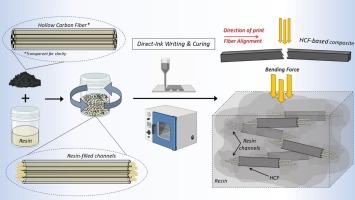Multichannel hollow carbon fiber reinforcement in an epoxy resin matrix for direct ink writing of high-performance composites
IF 7.9
2区 材料科学
Q1 MATERIALS SCIENCE, MULTIDISCIPLINARY
引用次数: 0
Abstract
Carbon-fiber reinforced polymers are widely used in additive manufacturing for high-performance composites. However, the aerospace and automotive sectors seek lighter materials compatible with practical processing methods. This study introduces hollow carbon fibers (HCFs) with a honeycomb cross-section as lightweight reinforcements in composites, fabricated via direct ink writing. The printability, mechanical performance, and microstructural features of HCF-based composites were systematically evaluated. Rheological testing showed that HCF-based inks exhibit similar pre-printing properties to conventional, densified carbon fiber (DCF) inks. However, mechanical tests revealed superior strength in traditional DCF composites due to differences in fiber morphology, density, and diameter. Microstructural analysis using small-angle X-ray scattering (SAXS) and optical microscopy indicated comparable fiber alignment, while scanning electron microscopy (SEM) showed complete epoxy infiltration in HCF channels, evidenced by the pullout of cured epoxy strands. While fiber–matrix interlocking was expected to enhance strength, weak bonding within HCF interiors contributed to reduced mechanical strength. Despite lower strength, HCFs offer advantages for applications prioritizing weight reduction, thermal insulation, or fluid permeability, such as lightweight aerospace and automotive components, thermal management systems, and filtration media. The hollow structure also enables integration with functional materials for smart materials and energy storage.

多通道中空碳纤维增强环氧树脂基体,用于高性能复合材料的直接油墨书写
碳纤维增强聚合物广泛应用于高性能复合材料的增材制造。然而,航空航天和汽车行业寻求与实际加工方法兼容的更轻的材料。本研究介绍了蜂窝截面的中空碳纤维(HCFs)作为复合材料的轻质增强材料,通过直接墨水书写制造。系统地评价了hcf基复合材料的可打印性、力学性能和微观结构特征。流变学测试表明,hcf基油墨与传统的致密碳纤维(DCF)油墨具有相似的印前性能。然而,机械测试显示,由于纤维形态、密度和直径的不同,传统的DCF复合材料具有优越的强度。使用小角度x射线散射(SAXS)和光学显微镜进行的微观结构分析表明,纤维排列相似,而扫描电子显微镜(SEM)显示,HCF通道中环氧树脂完全浸润,固化的环氧树脂链被拉出。虽然纤维基质联锁有望提高强度,但HCF内部的弱结合会降低机械强度。尽管强度较低,但hcf在优先考虑减重、隔热或流体渗透性的应用中具有优势,例如轻质航空航天和汽车部件、热管理系统和过滤介质。空心结构还可以与功能材料集成,用于智能材料和能量存储。
本文章由计算机程序翻译,如有差异,请以英文原文为准。
求助全文
约1分钟内获得全文
求助全文
来源期刊

Materials & Design
Engineering-Mechanical Engineering
CiteScore
14.30
自引率
7.10%
发文量
1028
审稿时长
85 days
期刊介绍:
Materials and Design is a multi-disciplinary journal that publishes original research reports, review articles, and express communications. The journal focuses on studying the structure and properties of inorganic and organic materials, advancements in synthesis, processing, characterization, and testing, the design of materials and engineering systems, and their applications in technology. It aims to bring together various aspects of materials science, engineering, physics, and chemistry.
The journal explores themes ranging from materials to design and aims to reveal the connections between natural and artificial materials, as well as experiment and modeling. Manuscripts submitted to Materials and Design should contain elements of discovery and surprise, as they often contribute new insights into the architecture and function of matter.
 求助内容:
求助内容: 应助结果提醒方式:
应助结果提醒方式:


